Photoemission from metal doped ice surfaces
Middle/Upper Atmosphere Laboratory, Past Research. 2006-2009
Water is the most common ice throughout universe. The behaviour of water ice films under bombardment by energetic particles and photons is of a considerable importance for the understanding of the physics and chemical processes in earth and other planets. Frozen water is a principal component of the surface of satellites and planetary rings.
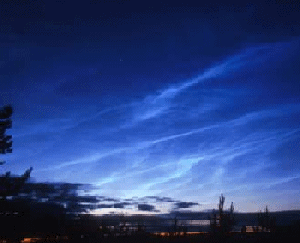 Noctilucent Clouds (NLCs)
Noctilucent Clouds (NLCs)
In the earth atmosphere fine ice particles form during the summer at high latitudes in the MLT (mesopause-lower thermosphere) region when the temperature falls as low as 130 K. The ice particles form thin noctilucent clouds (NLCs) (~1 km thick). The clouds can be visually observed during the twilight when the sun is below the horizon but still illuminates mesosphere. Strong VHF radar backscatter signals, termed Polar Mesospheric Summer Echoes (PMSEs), tend to coincide in time and altitude with NLCs, and seem to be a closely related phenomenon. The refractive index for mesospheric radars is determined by sharp gradients in the free electron density.
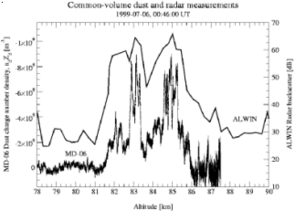 50 MHz radar backscatter in dB and the aerosol (dust) charge density as a function of height over Andoya, Norway (69 degrees N). The rocket payload (MD-06) flew through the ALWIN radar beam as it traversed the aerosol layer (courtesy of O. Havnes, University of Tromso)
50 MHz radar backscatter in dB and the aerosol (dust) charge density as a function of height over Andoya, Norway (69 degrees N). The rocket payload (MD-06) flew through the ALWIN radar beam as it traversed the aerosol layer (courtesy of O. Havnes, University of Tromso)
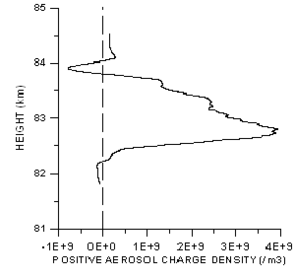 Measurements of positively charged aerosol density by electrostatic probes mounted on the front and rear of a rocket payload over Andoya, Norway (69 oN) during June 1994 [courtesy of T. Blix, Norwegian Defence Research Establishment]
Measurements of positively charged aerosol density by electrostatic probes mounted on the front and rear of a rocket payload over Andoya, Norway (69 oN) during June 1994 [courtesy of T. Blix, Norwegian Defence Research Establishment]
It is believed that PMSEs are caused mainly by ice particles with radii less than 10 nm, which are negatively charged by the attachment of electrons. The radar is then scattered from the sharp gradient in the free electron density around the cloud. Although rocket-borne measurements have confirmed that there is usually a 'bite-out' in the electron density profile at the altitude of a PMC, charged particle collectors on rockets have also shown that on rare occasions PMC particles are positively charged, with an enhanced cloud of electrons around them. Photoionisation of ice particles is clearly one potential mechanism for the generation of positively-charged particles. However, at heights below 100 km in the atmosphere there is insufficient intensity in the solar spectrum of photons of energy greater than the work function of ice (8.7 eV) to account for the observed charge density.
Attempts to simulate the experimental observations required the particles to have a work function on the order of 2.5 eV, much too low for pure water ice. In fact, PMCs occur in the same altitude range as metal atoms, such as Na and Fe, which ablate from the 20 - 50 tonnes of interplanetary dust that enters the atmosphere each day. This stimulated us to investigate the photoemission of metal doped ice films. The ice films are grown on a liquid nitrogen cooled support [Cu(111) single crystal surface] and exposed to a collimated beam of Na atoms. The surface is irradiated by a pulsed laser beam and electrons ejected from the surface are analysed by a time-of-flight mass spectrometer.
 Ultra high vacuum chamber and the detail of the target on which the ice film is grown
Ultra high vacuum chamber and the detail of the target on which the ice film is grown
Deposition of only 0.02 monolayers of Na leads to a dramatic decrease in the threshold for photoemission to (2.3±0.2) eV. Thus, photoelectrons can be generated by visible radiation in a 1 photon process with a cross section which exceeds 10-18 cm2. The ab-initio calculation indicate that the Na atom is located in the surface if the hexagonal ring of ice. The 3s orbital of the Na, which is a large component of the HOMO, becomes delocalized by this interaction with the surrounding H2O molecules. This probably accounts for the large photo-ionization cross section measured in the present study, compared with that for an isolated Na atom. The calculated vertical ionization potential is 3.0 eV, which is in very good accord with the measured threshold.
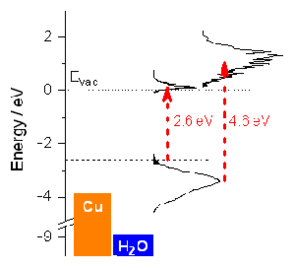
The initial state for photoemission is located between the Fermi level of the Cu(111)/H2O interface (3.9 eV) and the vacuum level. Photons of increasing energy sample deeper within the width of the initial state. The energy of the bound excited state observed in the optical transmission spectrum is indicated by the dotted level. The dashed line indicates the photoemission threshold derived from the wavelength dependence of the cross-section.
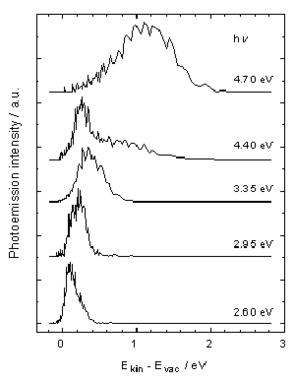 Photoemission spectra of Na doped ice surface. Dependence on the photon energy.
Photoemission spectra of Na doped ice surface. Dependence on the photon energy.
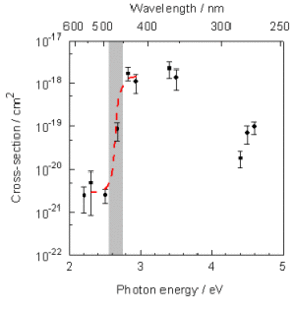 Photon energy dependence of the photoemission cross-section of the water ice surface doped with 0.02 ML of Na. The dashed line is only for leading of the eye.
Photon energy dependence of the photoemission cross-section of the water ice surface doped with 0.02 ML of Na. The dashed line is only for leading of the eye.
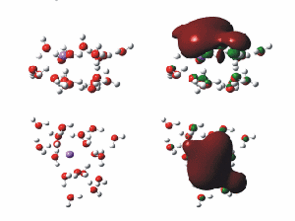 Calculated structures of a Na atom bound to a model ice surface consisting of 18 H2O molecules, at the B3LYP/6-311+g level of theory. The small white spheres are H atoms, the larger dark/red spheres are O atoms, and the large grey/purple sphere is the Na atom.
Calculated structures of a Na atom bound to a model ice surface consisting of 18 H2O molecules, at the B3LYP/6-311+g level of theory. The small white spheres are H atoms, the larger dark/red spheres are O atoms, and the large grey/purple sphere is the Na atom.
The occasionally observed layers of positive aerosol in mesosphere may originate from photoionization of ice particles doped by sodium in meteoritic trails.
References
- Vondrak, T.; Plane, J.M.C.; Meech S.R. , Influence of submonolayer sodium absorption on the photoemission of the Cu(111)/water ice surface, J. Chem. Phys., 2006, 125, 224702.
- Vondrak, T., Meech, S.R., Plane, J.M.C., Photoelectric emission from the alkali metal doped vacuum-ice interface, J. Chem. Phys., 2009, 130 (5), 054702.
